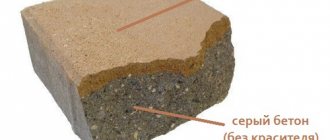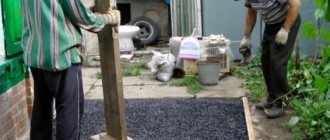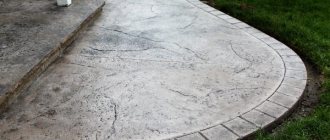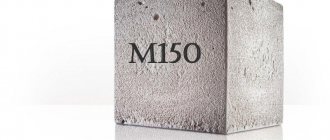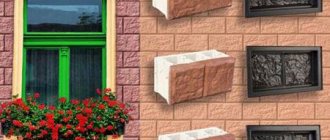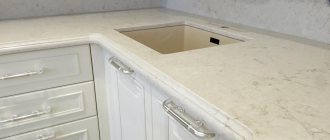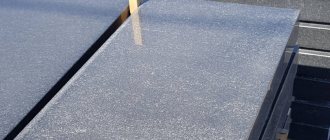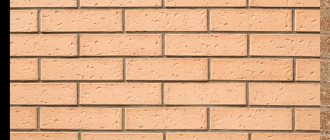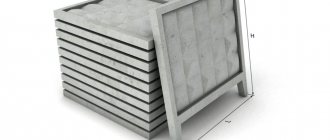Marble is considered one of the most attractive materials in terms of aesthetic and technical and operational qualities. However, the use of this stone is accompanied by difficulties in processing and transportation. And this is not to mention the high cost of natural mineral. Actually, the same situation is observed with a number of other rocks, including granite. Technology for the production of artificial analogues allows one to get rid of such shortcomings. In particular, cast marble has a more affordable price and allows you to obtain the required shape of the final product at the manufacturing stage. This can be an interior item, a purely decorative element of garden decoration, or panels for cladding. Of course, in the case of composite materials we cannot talk about complete similarity with the natural prototype, but in terms of the main characteristics, the imitation justifies itself.
Why choose artificial marble
If you still haven’t decided whether to make artificial stone using gypsum, you should consider some features of the material, including:
- Possibility of use in any room;
- availability of technology;
- low costs for self-production;
- possibility of interior design in an unusual style.
This stone is no different from natural stone in terms of environmental friendliness; it is even capable of regulating the indoor microclimate. The surfaces that you finish with gypsum stone will not lose their ability to breathe.
How to make artificial marble with your own hands
What is the stone we are interested in? It has a heterogeneous color, most often with veins penetrating the entire thickness, and a granular-crystalline structure. The color can be snow-white, pink, blue, black or gray. Less common colors: red, purple, green, yellow.
The easiest way to create the illusion of marble is with gypsum, which produces a dense, non-porous mass. However, this option is not acceptable if you need a countertop or cladding in a room with high humidity levels. Therefore, we will consider alternative methods that allow you to make artificial marble with your own hands.
The simplest technology is casting in molds from a cement-sand mixture. Cast marble is durable, waterproof and, most importantly, looks very similar to the real thing. However, it should be taken into account that thin tiles will be quite fragile, and thick ones will be heavy. As a result, it is possible to make a countertop from such an imitation, but the body of the furniture must be very massive in order to withstand the weight of the stone slab. A thinner version can be made using the wooden plane of the table itself as a basis. Next we will look at both options.
Types of Synthetic Marble Slabs
The following types of artificial (synthetic) marble are distinguished:
Cast marble, which is formed by forming a special mixture in molds - matrices.
Gypsum (touchstone)
Gypsum (touchstone) is a lighter material. This is a kind of gypsum mixture with adhesives, which is carefully polished at the final stage, and thanks to specially selected dyes it becomes as similar as possible to natural stone.
Crushed marble is characterized by its use as natural additives. It is a gray or white powder.
Liquid marble is a relatively recent invention; special technology makes it possible to obtain an extremely flexible and thin layer of artificial stone, which at the same time retains its characteristics and properties.
In more detail, you should familiarize yourself with the undisputed leader of this list - cast artificial marble, which is in greatest demand due to its performance and ease of production.
Tools and materials
To make marble from concrete, you will need the following building materials and equipment:
- mixer or drill with attachment;
- ceramic or marble chips, pebbles, and fine gravel are used as filler;
- polyethylene film;
- water-insoluble pigments for concrete, such as oil paint;
- purified fine sand;
- water;
- plasticizer that increases the strength of concrete;
- polyurethane matrix or plastic mold;
- cement.
To give the molded products the required density, it is better to use a vibrating platform or vibrating table. If it is not possible to mechanize the compaction process, then manual tamping is used.
Equipment
To produce cast marble, a small set of equipment is used:
- filling molds (matrices);
- gelcoat sprayer;
- mixer for stirring the composition;
- brushes for greasing molds.
Molds for marble production are made on the basis of polyurethane rubber. High-quality matrices, which are characterized by strength and are not prone to severe deformation, are very expensive. However, their cost pays off in full, since production is highly profitable.
Composition of raw materials
To make the material, acrylic or polyester resin and marble chips are mixed in a ratio of 4:1. For bonding, you can also use cement mortar, building gypsum, lime mortar with the addition of cement. But most often it is resins that are used, since they provide high strength to the material.
The filler function is sometimes performed by decorative materials (colored sand, pebbles, colored quartz). In this case, the finished products are not an analogue of natural stone, but a fundamentally new type of finishing materials.
To achieve the required color, mineral pigments are introduced into the mixture. The material is made in different colors, with inclusions and streaks. For this purpose, a special technique for mixing pigments is used. Pigments not only color the material, but also make it more resistant to external influences. The outer protective layer of gelcoat gives the coating a glossy shine.
Cast marble based on polyester resins
This method is somewhat more expensive, but the result is a beautiful texture of the outer coating. The material is very durable and lightweight, resistant to external mechanical and chemical influences.
- The first option is to prepare polymer concrete. Take 20-25% polyester resin and 80-75% filler. For this purpose, you can use quartz sand or other neutral colored mineral, finely crushed into crumbs.
- In the second case, instead of polyester resin, you can use a mixture of butacryl with AST-T in a ratio of 50x50 and add 50% crushed stone or quartz sand. Coloring is done with acrylic-based pigments.
- The form is filled and leveled over the surface of the matrix with a spatula. As a filler, you can use a chipboard board cut 5 cm smaller than the contour of the form. It is pressed into the mass, and the protruding excess is leveled along the back side of the casting.
- The dried and hardened product is removed from the mold and can be easily processed. It is amenable to grinding, drilling and other mechanical processing.
Manufacturing techniques
Several marble production technologies are used on an industrial scale. The composition of the mixtures depends on the chosen method. The most popular are casting and gypsum methods and the production of marble from concrete. Technologies for the production of artificial marble in both cases have much in common.
Casting method
Marble using the casting method is made from quartz sand or waste from the production of natural stone - marble chips. Polyester resins give the mixture integrity, and with the help of pigment the product can be given any shade. Cast marble has the following characteristics:
- good noise absorption;
- resistance to loads and shocks;
- plasticity, which makes it easy to cut and drill products without cracking or chipping;
- neutral to high and low temperatures and to most aggressive chemicals;
- the dense, non-porous structure does not allow dirt and food debris to accumulate on the surface;
- has low thermal conductivity and good insulating properties.
- molds for filling;
- anti-adhesive composition for mold processing;
- vibrating table;
- equipment for polishing finished marble structures;
- gelcoat
In addition to the main components of the mixture, a number of tools, preparations and special equipment are used in the production of cast marble. These include:
Anti-adhesive mixtures are used to treat the molds after removing the hardened stone.
The composition of such preparations includes paraffin or silicone dissolved in kerosene, white spirit or gasoline.
It is necessary to choose the composition based on the desired appearance of the stone.
To obtain a matte surface, a silicone mixture is suitable, while a wax anti-adhesive composition gives the final product a gloss, the surface becomes a little greasy.
The procedure for making cast marble is as follows:
- The inner surface of the pouring mold is treated with a pure solvent;
- the mold is heated to room temperature - about 25 ° C;
- apply an anti-adhesive compound using a brush or spray bottle and distribute it over the entire “working” surface of the mold with a clean rag;
- the processed form is dried for 5 minutes;
- if the form is used for the first time, treatment with the anti-adhesive mixture is repeated; when reusing the form, treatment is not necessary;
- while drying the mold, mix all the ingredients of the composition in a separate container - crumbs, resin and dye - mix thoroughly using an industrial mixer;
- the finished mixture is poured into a processed form and placed on a vibrating table;
- the mold is kept on the vibrating table for several hours to minimize the number of air bubbles and porosity of the finished product;
- 12 hours after pouring, the finished marble is removed from the mold and, if necessary, polished, cut or shaped into the desired shape;
- After processing, the product is cleaned of dust and treated with gelcoat.
- building gypsum;
- wood glue (Moment-Joiner, Super-PVA, Hercules and so on);
- polyester resin;
- water;
- dyes and additional components.
Gelcoat is a polymer resin that is given a desired shade using dyes. It performs several functions: protects the surface from damage, “closes” the pores of the product and colors it. The gelcoat is applied with a brush or spray in several layers. After the topcoat has dried (for gelcoat this is approximately 2-3 hours), the product is ready for use.
Gypsum marble
An alternative to stone made from natural chips is gypsum marble. Production using this recipe is much cheaper. The base mixture contains the following components:
First, plaster, glue and water are mixed, then resin is added, and everything is mixed using a mixer. Then are added to give color:
- black color is produced by aniline dye;
- a coffee shade can be obtained by using orange humilax (200 g) and 1 liter of technical alcohol per 50 kg of gypsum;
- For snow-white marble, white humilax is used.
The mixture is poured into a mold and dried for 10 hours at room temperature. After complete hardening, the artificial “gypsum” marble is removed, treated with potassium silicate, dried and polished with felt.
Gypsum marble is the lightest type of artificial stone, but also one of the most fragile. On its basis, decorative elements are usually made that are not subject to significant loads.
Concrete based
To manufacture a single product, it is not necessary to contact third-party manufacturers. If there are a number of readily available ingredients, anyone can create an artificial stone. You can make marble from concrete with your own hands. In addition to cement, marble contains sand, plasticizer and water. This greatly reduces the cost of artificial stone compared to the casting method. There are also certain requirements for such simple components.
To produce marble from concrete, the following materials and equipment are used:
- cement without additives (preferably grade M400-M500);
- multi-fraction sand (0.14−5 mm);
- plasticizer S-3;
- dyes;
- pure water;
- product mold;
- film;
- mesh or wire for reinforcement;
- container for mixing ingredients;
- industrial mixer or drill with attachment.
Production begins with careful sifting of sand. This will help get rid of excess impurities. The first to mix the basic components is cement and sand. The ratio of these components in the composition may vary depending on the scope of application of the final product.
- For parts that will be subject to a large amount of mechanical damage in the future - curbs, external cladding, paving slabs - you need to mix cement and sand in a ratio of 1:3.
- If you plan to make a countertop, ceiling or staircase element, or window sill from artificial marble, then the proportions should be 1:2.
- For decorative elements, cement and sand are mixed in a 1:1 ratio.
The mixture is then diluted with water. The volume of water is calculated based on the volume of the dry mixture: the recommended proportion is 1 part water to 2 parts of the mixture. First add about three-quarters of the water and mix. Then a plasticizer is added to the mixture at the rate of 1-2% by weight of cement and mixed.
For the best distribution of the plasticizer, the mixture is left for 10-15 minutes, and then the remaining water is poured in and mixed again.
The last component is dye. To achieve the desired shade, one or more pigments can be added. It is usually recommended to use pigment at a rate of 1% of the weight of the cement (rather than the entire mixture), but the effectiveness of dyes varies, so this ratio may not give the desired result. The most popular dyes and their recommended dosages are as follows:
- titanium oxide gives the mixture a white color (or white streaks and streaks), the recommended dosage is from 2 to 4%;
- minium - red-orange pigment - 5%;
- chromium oxide colors the composition green and is added in a volume of 3−5% of the weight of cement;
- The recommended amount for ocher is 5%, as a result the marble is painted in shades from light yellow to brown.
Special pigments for concrete are also produced. When determining their dosage, you must follow the manufacturer's instructions.
After adding the dye, the composition should not be thoroughly mixed, since marble has an uneven color distribution.
The finished mixture is poured in parts into a mold treated with anti-adhesive agents, paying special attention to the recesses. If the planned product is large, part of the composition is poured into the mold, mesh or wire is laid, and only then the rest of the liquid base is added. Typically, tabletops and massive slabs, borders, and volumetric decorative elements require reinforcement. After pouring, the mold is covered with film and left until completely hardened.
Artificial marble hardens for a long time; this will take at least 7-12 days. The finished stone is removed from the mold, polished if necessary and coated with a final protective layer of resin (gelcoat).
Features of the technology for producing marble from concrete
Making marble from concrete with your own hands is not difficult, the main thing is to follow the sequence of actions:
Concrete and cement are pre-screened, removing foreign objects and pebbles from it, and mixed in the selected proportion.
- Filler is added.
- The coloring pigment is mixed in with gentle movements (there is no need to make intense movements when stirring, the non-uniform mixture with stains is visually similar to real marble with characteristic veins). It is important not to overdo it with the amount of paint; its amount should be approximately 1% of the total amount of the mixture. Experiments are encouraged, during which several dyes of different shades are added. This approach will allow you to obtain the original color of the marble.
- Add water (1:2 in relation to the dry mixture) - 80% of the total volume, and a plasticizer, mix everything well and leave it alone for a few minutes so that the solution becomes viscous. Next, add another 20% of the remaining liquid.
- The finished solution is shaken and placed on a vibrating table for subsequent compaction;
- The raw materials are poured into molds, the surface of which is covered with plastic film.
To make a layer of artificial marble strong and durable, it is often reinforced. For this purpose, a metal wire is immersed in the solution poured into molds. After complete hardening (checked visually and by touching with a stick - if it is not “recessed”, then the marble is ready), the material is carefully removed from the mold, placed on the table and carefully polished. An angle grinder with diamond discs is suitable for these purposes. As a result, the surface of the material becomes perfectly smooth, and its texture closely resembles natural stone.
The technology for producing artificial marble from concrete allows, in a short period of time, to obtain a material that is not inferior to the original either in terms of aesthetic appeal or strength. The profitability of this type of business depends on the owner, on how competently he organizes the advertising of products and its subsequent sale wholesale and retail. Marble can be sold via the Internet, specialized warehouses and retail outlets. At the initial stages, you can set the price with a minimum markup, and increase it as your client base grows.
Manufacturing technology
The production of the finished product is not difficult and not expensive; you will need several available materials for making molds and a grinding machine. Do-it-yourself artificial marble is obtained by following the technological process; just follow a few simple steps. The production of artificial marble makes it possible to obtain a finished product of the desired type, give the structure uniqueness, and ensure the proper appearance.
Preparatory work
Before any work you will need the necessary materials. To obtain artificial marble you will need:
- Filler that is selected according to the budget. Ideally, marble chips are used; for a cheaper process, you should pay attention to crushed stone, quartz sand or a cement-sand mixture.
- Depending on the recipe and the desired result, a polyester resin is selected, preferably with an alcohol composition, as saturated as possible.
- Important parameters of high strength are achieved by using a hardener.
- Prepared dyes give the product color.
Do-it-yourself fillers for making artificial marble
The materials necessary for the production of artificial marble with your own hands can be purchased in specialized stores in construction markets. Only after all the preparatory work is it possible to begin work on the production of a mixture of material.
Preparation of the solution
The solution is prepared in a special container. The prepared ingredients are mixed in accordance with the proportions and recipe; the main requirements for mixing are the absence of lumps and a homogeneous mass at the output. For small volumes, it is possible to use an electric drill with a special stirring attachment, similar to a butterfly. Large volumes are mixed with a construction mixer.
Preparing and filling out the form
Before making a mold, it is necessary to determine whether it is advisable to produce a collapsible mold, because there are designs that are made once. The main materials for making molds are gypsum, polyurethane, plastic and others. The strength of the form depends on the volume and mass of the solution. Flow production involves division into sectors; this method is used when several products are made from a homogeneous composition.
The forms must be pre-polished and material applied to prevent adhesion. The gelcoat is sprayed onto the surface with a special cup device, then allowed to settle until completely cured. After pouring the material, it is necessary to remove air bubbles. This procedure is performed manually by piercing the mass over the entire area; for a faster, automated process you will need a vibrating table.
Hardening depends on the volume of the product and the ambient temperature. Filling is done in small layers to completely fill the form. The appearance of cracks on the surface of artificial marble is avoided by sealing with polyethylene or other available material.
Processing of the finished slab and subsequent care
The finished slab is processed with a grinding machine until shiny. Final polishing is done with felt; for a more pronounced shine, a polish is used, the color of which depends on the product.
Subsequent care requires special care; aggressive detergents can scratch the surface and remove shine. Removal of dirt is done with a soft cloth or a special sponge. To maintain shine, dilute a solution of detergent with water. The shine is maintained by rubbing with a towel after washing.
Main varieties
Artificial marble is made according to a simple procedure: a plastic mixture is prepared with various fillers and dyes, it is given the required shape, after which the mixture hardens to a solid state. In the solid state, the product is sanded to give it smoothness and gloss. Depending on the basis of the composition, three main types of artificial stone can be distinguished:
- based on a cement-sand mixture;
- based on polyester resins;
- Oselkovy (gypsum) marble.
All of them can be used to make artificial marble at home; this does not require expensive equipment, and all components can be purchased at hardware stores.
Of course, it is desirable to have a vibrating table, but for small production volumes you can do without it, you just need to make sure that the solution completely fills the mold, leaving no voids. When performing work using any technology, you will need forms made of plastic, gypsum, polyurethane or other suitable material. You can make a mold yourself from existing materials, for example, for a tile or a small tabletop you can make sides from wooden beams, and use glass for the bottom. The smoother the inner surface of the mold, the easier it will be to remove the product from it, and the less it will need to be sanded. It is best if the form can be disassembled.
Using cement
First you need to apply a layer of gelcoat to the inner surface of the mold. This layer will be the outer shell of the finished product, it is best to use a moisture resistant gelcoat. The color is chosen at your discretion. By mixing gels of different colors, you can get your own unique pattern of texture on the outer surface of the product.
You can also use a colorless gelcoat, in which case dyes will need to be added to the cement-sand mixture. You need to add the dye unevenly, in different portions at the very end of stirring the solution, so that when mixing you get veins of different thickness and direction, imitating the structure of natural stone. The solution is poured into the mold only after the gelcoat has completely dried. To prepare the solution, you need to take two parts of fine, well-sifted sand and one part of M-400 cement.
The filler for the mixture will be fine crushed stone; slaked lime, washing powder or liquid soap dissolved in water can be used as a plasticizer. Carefully fill the form with the prepared solution in small portions.
Excess solution is removed with a spatula, after which the mold is covered with plastic film, this will slow down the evaporation of moisture from the drying product. The drying time depends on the size of the product; after complete drying, it is carefully removed from the mold, sanded and polished the surface.
Based on polyester resins
Artificial stone made using this method is also called liquid marble. The cost of the components used in this method will be significantly higher, but the product will be lighter and stronger, which is important in the manufacture of many items. To prepare polymer concrete, you will need components in the following proportions:
- polyester resins - 1 part;
- filler (quartz sand or crushed crushed stone) - 3-4 parts.
Instead of polymer concrete, you can use a mixture of AST-T and butacryl (this is a cold-hardening plastic) with the addition of fine crushed stone, sand or marble chips as a filler. No more than 50% of the volume of polymer concrete is added.
First, apply gelcoat to the mold. The mixture is thoroughly mixed in a dry state, water is gradually added, and at the very end dyes are added. The mixture will begin to harden 15-20 minutes after adding water. As in the previous technology, the dyes must be mixed so that various lines and stripes are obtained that imitate the veins in real stone. Polymer concrete is poured into the mold, after 10 hours the finished product can be removed. If necessary, the surface of the product is ground and polished.
Oselkovy marble made of gypsum
This type of artificial stone is a mixture of gypsum, adhesive and dyes.
Glue is added to the water and mixed well, the plaster is sealed with this water and mixed thoroughly. The proportions of the components are selected individually, the main thing is that the solution is quite liquid to completely fill the mold. Glue should be added to water 2-3% of the total volume. The glue, firstly, will serve as a substance that strengthens the solution, and secondly, it will increase the hardening time of the solution, which is very important for gypsum mixtures. A small part of the solution is placed in the prepared form, dyes are added, and stirred until lines and stripes are obtained that resemble the structure of natural stone. Immediately spread the rest of the solution on top of this layer. After the mixture has dried, the product is carefully polished; the polished surface resembles such types of stone as lapis lazuli and malachite.
Undoubtedly, cast marble has the best performance qualities, but at the same time it will also be the most expensive. This material has a very wide range of applications. Products based on a cement-sand mixture will be durable, but heavy; floor tiles or borders and other massive structures are mainly made in this way.
Gypsum-based marble will be lighter and more fragile; this material is recommended for use in the manufacture of facing tiles and other items used indoors.
How to make an illusion faux marble
If you want imitation stone to cover an elegant coffee table, you will have to abandon the previously described technology, since it is unlikely that thin wooden legs will withstand the load of a multi-kilogram slab. Instead, the easiest way is to use paints to partially turn the table itself into marble by painting the appropriate stains on it. To do this, you will need a jar of paint for the background, for example, white or green, as well as a small container of color for the pattern. It would be more correct to draw black or gray stripes on a white background, and white stripes on a green or black background.
Before making artificial marble, all cracks and chips on the surface, if any, are filled with a special water-based wood filler. Next, we moisten the tabletop with a spray bottle so that the swollen fibers reveal all the roughness, and, after the 30 minutes required for drying, we sand it as best as possible to a smooth state. Then, having cleaned the surface, we proceed to painting and apply two background layers with the interval necessary for the first of them to dry.
To avoid streaks, it is better to use a brush or foam pad. After two hours, you can begin applying the texture pattern.
The pattern of marble is familiar to many; sometimes it resembles zigzags of lightning on a surface speckled with many grains, and sometimes it looks like randomly intersecting cracks. All this is not difficult to depict with a pen brush, with which you can change the thickness of the line. After waiting 5 minutes, mix a small amount of white paint with a transparent polyacrylic coating.
Having dipped a wet sponge into the mixture (be sure to remove excess mixture from it), we follow the drawing without pressing hard and thus shade the lines, making them more blurry. After another 5 minutes of drying, wipe the surface with a clean cloth, mixing the colors with light touches. Another 30 minutes of drying and we take up the feather brush again, emphasizing the previously applied and already modified pattern.
After two hours, when the surface has already dried well, we take a thoroughly mixed polyacrylic coating and cover our “marble” with a thin transparent layer. It is advisable to leave the tabletop for a long time after this to allow the film to harden thoroughly. Next, you need to polish the surface with the finest sandpaper, clean it with a damp sponge or cloth and, after letting it dry, treat it again with polyacrylic.
Again, we leave the almost formed imitation stone to dry for 2-3 hours, then polish and wipe again. We apply the last layer of transparent coating, wait for it to harden (2-3 hours), and finally polish it, after which we forget about our piece of furniture for about a week.
Nuances of operation
With proper finishing treatment of artificial marble of any origin, products made from it will last for years.
One of the ways to increase the durability of the stone is surface painting and coating with water-acrylic varnish. This is especially true for stone used in exterior decoration, since water-acrylic varnish is not affected by sunlight.
As a result, the marble decorative element will not change its color and will not become covered with unpleasant yellow spots for 10-15 years.
When installing the product, avoid over-tightening fasteners. A marble slab installed skewed or with strong pressure on the corners may not withstand the load and burst. When cladding rooms with high humidity, it is necessary to monitor the condition of the plumbing, prevent leaks and stone from getting under digging.
Falling heavy objects with sharp corners can damage the marble. Do not cut food directly on the countertop; use cutting boards.
The surface should be cleaned using only liquid cleaning agents. Compositions with abrasives destroy the protective coating of artificial stone, causing micro-scratches in which food residues, dust and other contaminants accumulate. Hard brushes and metal meshes should be abandoned, giving preference to soft fabrics.
It is also recommended to cover artificial marble with a concrete primer at least once a year after cleaning. In this case, it will last much longer.
Oselkovy marble on finished surfaces
I decorate premises using the rare “Touchstone Marble” technique, with a high degree of imitation of natural stone. I work on a finished surface. I really am the bearer of the original technology. My surface is not the gloss of wax, it is the polish of stone. In some cases, I use wax coatings only to make the surface less hygroscopic or at the request of the customer.
For those who don't know. “Oselkovy marble” is a type of decorative plaster, used for palaces. Base: Gypsum binders. A detailed description of the decorative properties can be found on the websites of colleagues, but I won’t go into details myself. I will only say that as a result of special composition of the sealing vein and stepwise strengthening of the surface, the gypsum acquires sufficient hardness to accept polishing. This is ten times harder than a regular plaster product. I apply the touchstone over the existing surface. I can note that there are no offers for walls using this technique on the market! And what does exist costs as much as a Bentley.
Call, write, ask questions. ru Cost of work: - Marble surface painting at Moscow prices varies from 3 to 7 thousand rubles. m. sq. — Imitation of “Touchstone marble” from Venetian plaster — 3-5t. R. Oselkovy with finishing polishing - 10-20t. rm. sq. , with wax - 9t. R. I note that the cost is greatly influenced by the layer and complexity of the design. 2-3 cm of layer and in wax will cost 20 thousand rubles. m. sq. So a column with a body height of 3 m and a diameter of 40 cm can be priced from 90 to 150 thousand rubles. Let me note once again that the market supply is ONLY for products. Almost no one offers walls due to the inability of the mixture of colleagues to stick to the surface without a mesh, and the mesh has a bad reputation. Or they offer installation of pieces made in the workshop with subsequent sealing of the junction. My mixtures adhere perfectly to the wall. I have samples on laminated chipboard and even on thin plastic. That's why I put emphasis on originality. This is Oselkovy marble on the finished surface! My prices for Oselkov marble based on the finished surface range from 9 to 24 thousand rm. sq. and the main determining factor of cost here is LAYER. The drawing does not greatly affect the cost.
Application of artificial marble
In construction work, artificial stone is used for the following purposes:
- finishing and thermal insulation of building facades;
- cladding of plumbing products;
- production of furniture, window sills, tabletops and bar counters;
- elements of stairs - balusters, railings, steps;
- production of paving slabs.
Artificial marble is used to create landscape designs - flowerpots, benches, paths, decorative sculptures and fountains.
Make it at home: ingredients
The process of making artificial marble with your own hands is not much different from the industrial method. The same tool can be used, but it will be impractical to buy expensive molds to create one product. That is why there are many ways to make matrices yourself.
Typically, plastic containers of suitable size and configuration are used for this. To make a regular stove, a wooden pallet with folding sides will be sufficient. Dimensional accuracy will not be so important, because the finished product can be trimmed to the required size.
The presence of a vibrating table will greatly facilitate the task and make the structure of the artificial stone more durable and uniform, but for lack of a better one, you can use the manual mixing method. The gelcoat layer can also be applied with a hand sprayer or a regular paint brush. In general, any home craftsman can independently choose what to replace industrial equipment with. Special stirring containers can be successfully replaced with a “mixer” attachment for an electric drill. The top layer of the homemade mold is insulated with plastic film for successful removal from the frozen mass.
Artificial marble is an excellent finishing material that is widely used in everyday use. It is used for aesthetically attractive and durable cladding of internal walls and external facades of buildings.
The video shows how to make artificial marble at home:
Floor tiles made from this material are extremely resistant to abrasion and mechanical damage, and kitchen countertops and backsplashes very successfully resist the aggressive effects of temperature and chemicals. Cement mortar is used to fix the tiles. Read about what is good about GOST 30515 2013.
Sinks made of artificial marble are distinguished by their excellent design and trouble-free operation. Making artificial marble yourself will significantly reduce the cost and allow you to obtain original configurations and colors of finished products.
Pros and cons, reviews
Although the composition of artificial marble is fundamentally different from its natural counterpart, it has the same technical properties. Moreover, the level of strength and wear resistance of artificially produced material is several times higher than that of natural material.
The main advantages of artificial marble:
- has a high level of mechanical strength and is not afraid of impacts;
- is durable and has a long service life;
- almost does not conduct heat and electricity, has a high level of fire safety. Therefore, it can be used to decorate heating radiators, electric stoves, etc.;
- the material does not heat up, does not delaminate, is not afraid of acids, alkalis, solvents, does not absorb fat, and does not leave stains on it. Due to this practicality, it is often used to decorate kitchens and bathrooms, and finish floors in residential, industrial and public spaces;
- does not emit harmful substances, is environmentally friendly;
- Thanks to the external gelcoat coating, it looks aesthetically pleasing and can be used for decorative purposes.
It combines the hardness of natural stone and ease of processing. Unlike natural marble, artificial material provides a greater degree of comfort and is always warm to the touch.
Among the disadvantages of artificial stone, many note that it cannot be considered a complete analogue of natural material. It feels more like plastic, and the top coating looks like polyurethane.
In addition, the gel coating often cracks over time. As a result, the material becomes discolored and destroyed.
Average cost of artificial marble
The marble manufacturing process involves minimal investment and very high profitability. Initially, costs are incurred for the purchase of equipment, raw materials, rent of premises and production of matrices. In the future, the cost of products is determined mainly by the cost of raw materials.
The production cost is estimated at approximately $5 per 1 sq. m. m., while the market price reaches $30 per 1 sq. m. m. or even higher.
Various products and materials made from artificial marble are considered as beautiful, strong and durable as products made from real natural stone. After all, its production has been improved over the course of 30 years and achieved high results.
Sources
- https://FB.ru/article/295715/kak-sdelat-iskusstvennyiy-mramor-iz-gipsa-svoimi-rukami
- https://remoskop.ru/sdelat-iskusstvennyj-mramor-svoimi-rukami.html
- https://1beton.info/izdeliya/mramor-iz-betona
- https://stroyres.net/kamennye-materialy/mramor/iskysstvenyi
- https://proffstroygroup.ru/materialy/imitaciya-granita-svoimi-rukami.html
- https://stankiexpert.ru/spravochnik/materialovedenie/iskusstvennyjj-mramor.html
- https://TvoiDvor.com/beton/tehnologiya-izgotovleniya-iskusstvennogo-mramora-iz-betona/
[collapse]
Usage
Here everything is limited only by your imagination! Artificial marble is widely used as a facing material, both indoors and outdoors. Facades made of artificial marble are absolutely resistant to weather conditions, ultraviolet radiation and mechanical damage. The scope of application of this material is very wide; good strength and harmlessness to others will allow the material to perform a wide variety of tasks.
The video shows the use of artificial marble:
Some examples of using artificial stone:
- Manufacturing of kitchen sinks and washbasins for bathrooms.
- Tabletops and work surfaces.
- Kitchen apron.
- Cladding of walls and external facades.
- Floor tiles.
- Covering steps for stairs.
- Cladding of columns and decorative elements.
- Installation of borders, baseboards and decorative bumpers.
In principle, artificial stone in general and marble in particular can be used to decorate any interior detail. Depending on the type of molding mixture, marble can form a rather thin layer, which is successfully used for interior wall coverings instead of traditional wallpaper.
